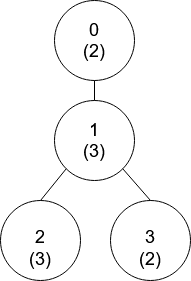1766. Tree of Coprimes
Description
There is a tree (i.e., a connected, undirected graph that has no cycles) consisting of n nodes numbered from 0 to n - 1 and exactly n - 1 edges. Each node has a value associated with it, and the root of the tree is node 0.
To represent this tree, you are given an integer array nums and a 2D array edges. Each nums[i] represents the ith node's value, and each edges[j] = [uj, vj] represents an edge between nodes uj and vj in the tree.
Two values x and y are coprime if gcd(x, y) == 1 where gcd(x, y) is the greatest common divisor of x and y.
An ancestor of a node i is any other node on the shortest path from node i to the root. A node is not considered an ancestor of itself.
Return an array ans of size n, where ans[i] is the closest ancestor to node i such that nums[i] and nums[ans[i]] are coprime, or -1 if there is no such ancestor.
Example 1:

Input: nums = [2,3,3,2], edges = [[0,1],[1,2],[1,3]] Output: [-1,0,0,1] Explanation: In the above figure, each node's value is in parentheses. - Node 0 has no coprime ancestors. - Node 1 has only one ancestor, node 0. Their values are coprime (gcd(2,3) == 1). - Node 2 has two ancestors, nodes 1 and 0. Node 1's value is not coprime (gcd(3,3) == 3), but node 0's value is (gcd(2,3) == 1), so node 0 is the closest valid ancestor. - Node 3 has two ancestors, nodes 1 and 0. It is coprime with node 1 (gcd(3,2) == 1), so node 1 is its closest valid ancestor.
Example 2:

Input: nums = [5,6,10,2,3,6,15], edges = [[0,1],[0,2],[1,3],[1,4],[2,5],[2,6]] Output: [-1,0,-1,0,0,0,-1]
Constraints:
nums.length == n1 <= nums[i] <= 501 <= n <= 105edges.length == n - 1edges[j].length == 20 <= uj, vj < nuj != vj
Solutions
Solution: Depth-First Search
- Time complexity: O(n*Max(nums))
- Space complexity: O(n+Max(nums))
JavaScript
/**
* @param {number[]} nums
* @param {number[][]} edges
* @return {number[]}
*/
const getCoprimes = function (nums, edges) {
const n = nums.length;
const tree = Array.from({ length: n }, () => []);
const maxNum = Math.max(...nums);
const stack = Array.from({ length: maxNum + 1 }, () => []);
const result = Array.from({ length: n }, () => -1);
for (const [u, v] of edges) {
tree[u].push(v);
tree[v].push(u);
}
const gcd = (a, b) => (b ? gcd(b, a % b) : a);
const getAncestor = node => {
let maxDepth = -1;
let result = -1;
for (let num = 1; num <= maxNum; num++) {
if (!stack[num].length) continue;
const ancestor = stack[num].at(-1);
if (ancestor.depth > maxDepth && gcd(nums[node], num) === 1) {
maxDepth = ancestor.depth;
result = ancestor.node;
}
}
return result;
};
const dfsTree = (node, prev, depth) => {
const num = nums[node];
result[node] = getAncestor(node);
stack[num].push({ node, depth });
for (const neighbor of tree[node]) {
if (neighbor === prev) continue;
dfsTree(neighbor, node, depth + 1);
}
stack[num].pop();
};
dfsTree(0, -1, 0);
return result;
};